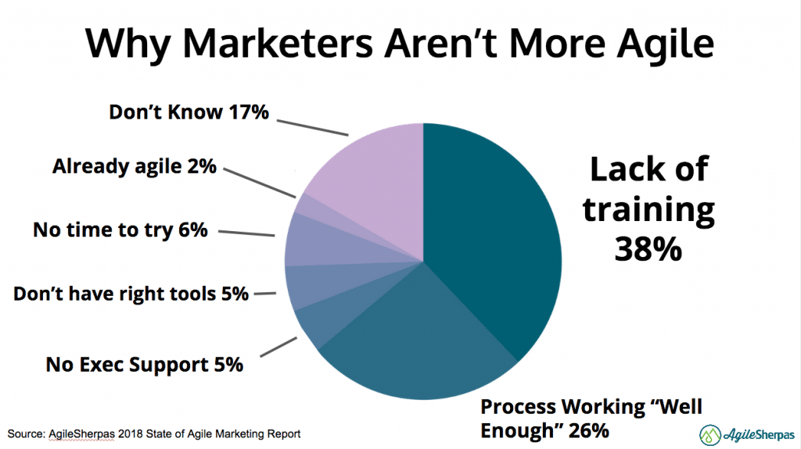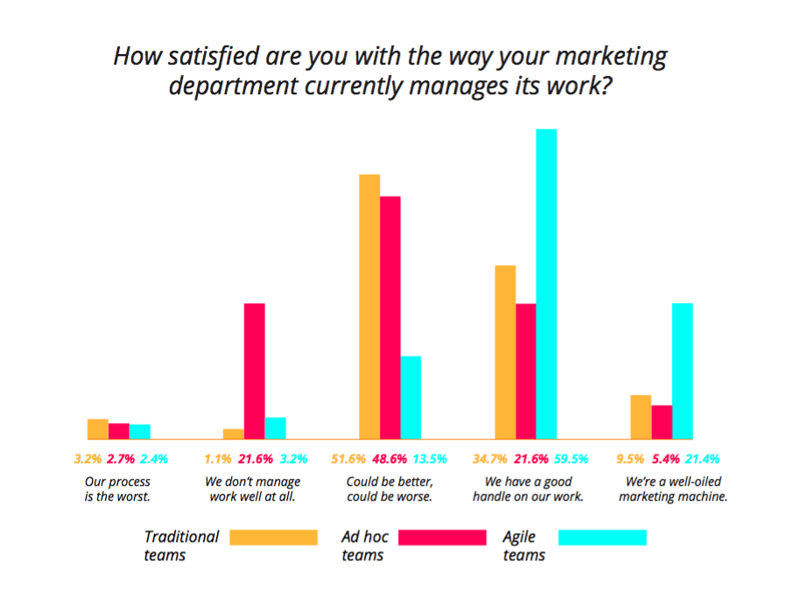Like a delicious, nutritious kale smoothie, Agile marketing is packed full of great benefits. And like a top-quality blender, formal Agile marketing training makes it even better.
But again like a top-quality blender, training can be expensive.
Are Agile marketing workshops, coaching, and training really worth the cost?
As a coach myself I’ll admit to being more than a little biased towards a resounding “Yes!” to that question, but I also wanted some solid evidence to back up my gut feeling.
So here you’ll find multiple data sets that make the case for Agile marketing training.
The argument I’ll lay out goes like this:
- Agile coaches and training help Agile take hold faster, minimize its disruptions, and ensure it sticks around.
- Agile has many quantifiable benefits for marketing teams (we’ll look at employee retention and the ROI of marketing campaigns here).
- Because of its ability to deliver the benefits of Agile, Agile marketing training has very high ROI itself.
The short version: Agile marketing training pays for itself many times over.
There’s a lot of data there to unpack, but first let’s establish that Agile marketing training does in fact help teams and organizations succeed.
The Agile Marketing Education Gap
Our recent State of Agile Marketing Report found that 55% of Agile marketing teams enjoy an increased ability to change gears based on incoming feedback.
Another 52% gained better visibility into project status.
And 47% are producing a higher quality of work following their Agile transformation.
But if Agile marketing is so great, why have only 37% of marketing teams made the switch? It turns out that we’re struggling against an education deficit, with 38% of respondents citing a lack of training as the primary barrier to increased agility.
How Training Helps Agile Marketing Teams
According to marketing teams who have already transitioned to Agile, education played a key role in their success.
We asked them to identify the tools that were most valuable during their adoption of Agile, and training was a recurring theme:
- Online training and webinars: 44%
- External classes or workshops: 33%
- External Agile consultants or trainers: 26%
- Company-provided training program: 25%
- Internal Agile coaches: 23%
In addition, the most recent VersionOne State of Agile Report asked thousands of agilists what was helping them scale Agile, and 53% said internal coaches were the most helpful. Of those facing challenges with scaling, 35% pointed to insufficient training and education as the cause.
So it’s clear that Agile coaches and training help Agile work, but is it that a good enough reason to invest your hard-won budget?
Time to move on to part two of our argument, that Agile has real, quantifiable benefits for marketing teams.
The High Cost of Employee Turnover
According to a paper from the Center for American Progress, which compiled data from 11 research papers published over a 15-year period, when a highly skilled employee leaves it costs a company 213% of that person’s yearly salary.
So if we lose a digital marketing associate who makes $50k per year, it costs us $106,500.
The departure of a more senior employee who makes $85k incurs a cost of $181,050.
Those numbers, of course, don’t include everything a long-time employee takes with them inside their head. Institutional knowledge and an understanding of the customer are lost too, though it’s harder to put a firm dollar amount on those.
The bottom line is that losing people is expensive, and it’s beneficial to keep them around.
Agile Marketing and Employee Satisfaction
Agile marketing significantly increases employee satisfaction, according to both our own State of Agile Marketing Report and independent results from Agile marketing teams.
First off, 35% of Agile respondents in our study reported improved team morale as a benefit of going Agile. And when we compare how happy marketers are with work management, Agile teams are far more likely to say their process works well:
Second, marketing teams who regularly measure their employee satisfaction and engagement see major gains in these areas following Agile adoption. CA Technologies, for example, surveyed their marketers before and after Agile took hold and reported the following outstanding results:
- Engagement increased 6 points
- Feeling “Proud to work for CA” increased 11 points
- Marketers were more likely to “Recommend CA as a great place to work” by 31 points
- They felt more “Appropriately involved in decisions affecting their work” by 11 points
- Feeling “Valued as an employee” was up 20 points
Quantifying the Impact of Agile Marketing
Going back to our earlier examples, let’s say a traditional marketing team typically loses two employees per year, and that together their salaries average $70,000. That means the cost of that turnover is 213% of $70,000, or $149,100.
If investing just $10,000 in Agile marketing training could keep one of those employees from leaving, it would reduce that impact by half, netting the department a savings of $64,550 (half of the $149,100 minus the $10,000 investment).
A bigger investment of $50,000 might eliminate turnover altogether, which would end up having a net positive impact of $99,100 even after we take out the cost of the training.
Agile Marketing and ROI
Now that we’ve started talking numbers, let’s investigate the potential impact Agile marketing can have on the measurable ROI of marketing work.
For our purposes here we’re going to use ROI as a pretty generic term. Yours might come in the form of new accounts if you’re marketing a SaaS product, or maybe it’s measured in actual sales if you’re in a B2C environment.
The point is whatever ROI looks like in your marketing department, it’s almost certainly going to go up following an Agile transformation, and here’s why.
How Agile Makes Marketing Worth More
Whether they’re using Scrum, Kanban, or some hybrid of the two, most Agile marketing teams end up being able to release marketing work about every two weeks, so we’re going to use that as our benchmark.
We’ll be generous and assume that pre-Agile a team was releasing a campaign every two months (though some of us are nowhere near that fast).
If we go from releasing every two months to every two weeks, we’re now delivering 26 campaigns each year instead of just six. That’s an increase in frequency of over 400%, which means we should see a corresponding increase in the annual ROI for marketing.*
So if in our pre-Agile days we got 200 MQLs out of each campaign, and we were releasing six campaigns per year, we’d deliver about 1,200 MQLs annually.
Post-Agile the same team is able to release 26 campaigns of comparable size, each of which brings in 200 MQLs. So they’re now getting 5,200 MQLs each year with no increase in budget or headcount.
That’s 4,000 additional MQLs EVERY YEAR, all for the price of some Agile marketing training.
The Value of Agile Iteration
Of course, Agile marketing isn’t just about speed. Remember that 47% of Agile marketing teams tell us that they’re getting higher quality work in their post-Agile reality.
One of the main reasons that happens is through the power of iteration.
Each time an Agile team releases work, they pause to inspect, adapt, and improve both their process and the work it produces. That means each campaign is a little better than the one before it.
Let’s go back to our two-week campaign (the one that took us two months before Agile marketing). Without any iterative improvement each campaign produces 200 MQLs.
Now let’s imagine that our inspect and adapt cycle allows us to gain a very modest 2.5% increase in ROI each time we release. Our MQL count would look something like this:
Agile Campaign 1 = 200 MQLs
Agile Campaign 2 = 205
Agile Campaign 3 = 210
Agile Campaign 4 = 215
Agile Campaign 5 = 220
Agile Campaign 6 = 225
Agile Campaign 7 = 231
Agile Campaign 8 = 237
Agile Campaign 9 = 243
Agile Campaign 10 = 249
You get the idea.
This increase would continue with each Agile campaign, and we’re being pretty conservative with our iterative improvement estimate. It’s likely that our Agile process would uncover opportunities for much larger gains by putting campaigns in front of our audience more frequently.
Agile Value in Real Dollars
For our final step, let’s see if we can get to real dollars.
For those in the B2C world, we could swap out MQLs for actual sales. For the sake of round numbers, let’s imagine our average campaign brings in $10,000 in new sales.
Using the six to 26 campaign increase, that’s 20 additional campaigns that bring in an additional $200,000 in revenue. Um...yes, please.
For our B2B friends, you’d need to know the average dollar value of an MQL for this last bit to work, but let’s assume that we do.
Let’s stay conservative and say our MQL’s average value is $250. Our Agile marketing team is getting 4,000 more MQLs per year thanks to their increase in speed, which delivers $1,000,000 in revenue.
Yup. A million dollars. Makes that training class and coaching seem like a pretty good deal, doesn’t it?
Agile Marketing Training and Reality
I’ve been a digital marketer for fourteen years, so I fully understand that there are a lot of moving parts in a marketing team that can put a dent in some of these raw numbers.
But research from outside the Agile world backs it up. Dr. Laurie Bassi, a human capital analysis specialist, found that companies get a 300% return on their investment into training and development. They saw 218% higher income per employee, as well as a 24% higher profit margin.
So even if your internal complications decrease some of the positive impacts outlined above, there’s no denying that Agile marketing training is worth the time and investment.
If you’re looking for options, we’d love to chat. You can also check out our workshop descriptions.
* There are certainly arguments against releasing more and more campaigns to the same audience, and evidence that there would be some diminishing return on each campaign if you oversaturate a market. But those complexities are beyond our scope for this article.







